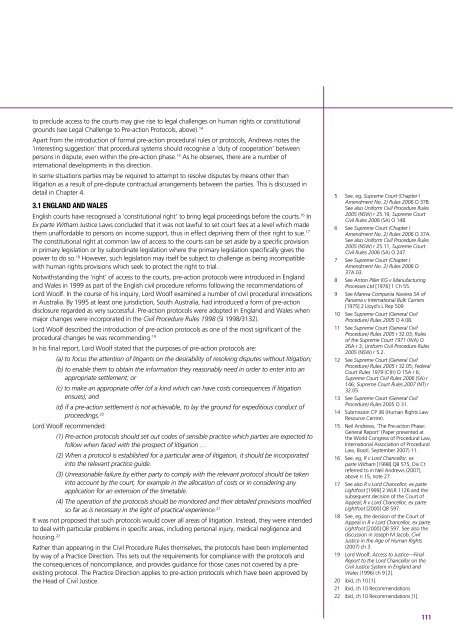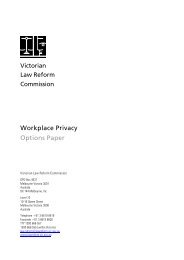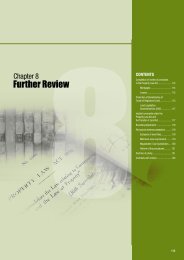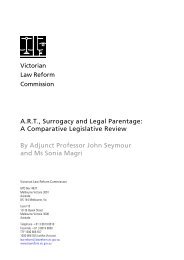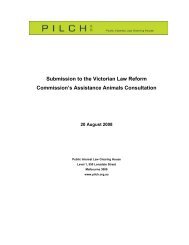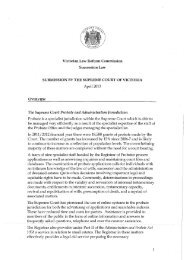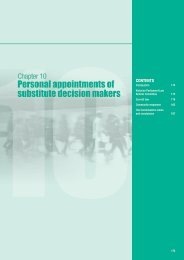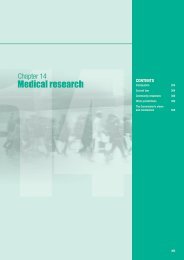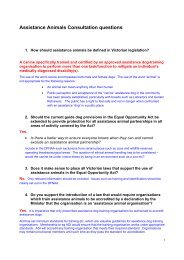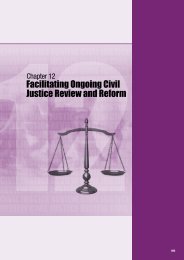Facilitating the Early Resolution of Disputes without Litigation
Facilitating the Early Resolution of Disputes without Litigation
Facilitating the Early Resolution of Disputes without Litigation
Create successful ePaper yourself
Turn your PDF publications into a flip-book with our unique Google optimized e-Paper software.
to preclude access to <strong>the</strong> courts may give rise to legal challenges on human rights or constitutionalgrounds (see Legal Challenge to Pre-action Protocols, above). 14Apart from <strong>the</strong> introduction <strong>of</strong> formal pre-action procedural rules or protocols, Andrews notes <strong>the</strong>‘interesting suggestion’ that procedural systems should recognise a ‘duty <strong>of</strong> cooperation’ betweenpersons in dispute, even within <strong>the</strong> pre-action phase. 15 As he observes, <strong>the</strong>re are a number <strong>of</strong>international developments in this direction.In some situations parties may be required to attempt to resolve disputes by means o<strong>the</strong>r thanlitigation as a result <strong>of</strong> pre-dispute contractual arrangements between <strong>the</strong> parties. This is discussed indetail in Chapter 4.3.1 England and WalesEnglish courts have recognised a ‘constitutional right’ to bring legal proceedings before <strong>the</strong> courts. 16 InEx parte Witham Justice Laws concluded that it was not lawful to set court fees at a level which made<strong>the</strong>m unaffordable to persons on income support, thus in effect depriving <strong>the</strong>m <strong>of</strong> <strong>the</strong>ir right to sue. 17The constitutional right at common law <strong>of</strong> access to <strong>the</strong> courts can be set aside by a specific provisionin primary legislation or by subordinate legislation where <strong>the</strong> primary legislation specifically gives <strong>the</strong>power to do so. 18 However, such legislation may itself be subject to challenge as being incompatiblewith human rights provisions which seek to protect <strong>the</strong> right to trial.Notwithstanding <strong>the</strong> ‘right’ <strong>of</strong> access to <strong>the</strong> courts, pre-action protocols were introduced in Englandand Wales in 1999 as part <strong>of</strong> <strong>the</strong> English civil procedure reforms following <strong>the</strong> recommendations <strong>of</strong>Lord Woolf. In <strong>the</strong> course <strong>of</strong> his inquiry, Lord Woolf examined a number <strong>of</strong> civil procedural innovationsin Australia. By 1995 at least one jurisdiction, South Australia, had introduced a form <strong>of</strong> pre-actiondisclosure regarded as very successful. Pre-action protocols were adopted in England and Wales whenmajor changes were incorporated in <strong>the</strong> Civil Procedure Rules 1998 (SI 1998/3132).Lord Woolf described <strong>the</strong> introduction <strong>of</strong> pre-action protocols as one <strong>of</strong> <strong>the</strong> most significant <strong>of</strong> <strong>the</strong>procedural changes he was recommending. 19In his final report, Lord Woolf stated that <strong>the</strong> purposes <strong>of</strong> pre-action protocols are:(a) to focus <strong>the</strong> attention <strong>of</strong> litigants on <strong>the</strong> desirability <strong>of</strong> resolving disputes <strong>without</strong> litigation;(b) to enable <strong>the</strong>m to obtain <strong>the</strong> information <strong>the</strong>y reasonably need in order to enter into anappropriate settlement; or(c) to make an appropriate <strong>of</strong>fer (<strong>of</strong> a kind which can have costs consequences if litigationensues); and(d) if a pre-action settlement is not achievable, to lay <strong>the</strong> ground for expeditious conduct <strong>of</strong>proceedings. 20Lord Woolf recommended:(1) Pre-action protocols should set out codes <strong>of</strong> sensible practice which parties are expected t<strong>of</strong>ollow when faced with <strong>the</strong> prospect <strong>of</strong> litigation …(2) When a protocol is established for a particular area <strong>of</strong> litigation, it should be incorporatedinto <strong>the</strong> relevant practice guide.(3) Unreasonable failure by ei<strong>the</strong>r party to comply with <strong>the</strong> relevant protocol should be takeninto account by <strong>the</strong> court, for example in <strong>the</strong> allocation <strong>of</strong> costs or in considering anyapplication for an extension <strong>of</strong> <strong>the</strong> timetable.(4) The operation <strong>of</strong> <strong>the</strong> protocols should be monitored and <strong>the</strong>ir detailed provisions modifiedso far as is necessary in <strong>the</strong> light <strong>of</strong> practical experience. 21It was not proposed that such protocols would cover all areas <strong>of</strong> litigation. Instead, <strong>the</strong>y were intendedto deal with particular problems in specific areas, including personal injury, medical negligence andhousing. 22Ra<strong>the</strong>r than appearing in <strong>the</strong> Civil Procedure Rules <strong>the</strong>mselves, <strong>the</strong> protocols have been implementedby way <strong>of</strong> a Practice Direction. This sets out <strong>the</strong> requirements for compliance with <strong>the</strong> protocols and<strong>the</strong> consequences <strong>of</strong> noncompliance, and provides guidance for those cases not covered by a preexistingprotocol. The Practice Direction applies to pre-action protocols which have been approved by<strong>the</strong> Head <strong>of</strong> Civil Justice.5 See, eg, Supreme Court (Chapter IAmendment No. 2) Rules 2006 O 37B.See also Uniform Civil Procedure Rules2005 (NSW) r 25.19, Supreme CourtCivil Rules 2006 (SA) O 148.6 See Supreme Court (Chapter IAmendment No. 2) Rules 2006 O 37A.See also Uniform Civil Procedure Rules2005 (NSW) r 25.11, Supreme CourtCivil Rules 2006 (SA) O 247.7 See Supreme Court (Chapter IAmendment No. 2) Rules 2006 O37A.03.8 See Anton Piller KG v ManufacturingProcesses Ltd [1976] 1 Ch 55.9 See Mareva Compania Naviera SA <strong>of</strong>Panama v International Bulk Carriers[1975] 2 Lloyd’s L Rep 509.10 See Supreme Court (General CivilProcedure) Rules 2005 O 4.08.11 See Supreme Court (General CivilProcedure) Rules 2005 r 32.03; Rules<strong>of</strong> <strong>the</strong> Supreme Court 1971 (WA) O26A r 3; Uniform Civil Procedure Rules2005 (NSW) r 5.2.12 See Supreme Court (General CivilProcedure) Rules 2005 r 32.05; FederalCourt Rules 1979 (Cth) O 15A r 6;Supreme Court Civil Rules 2006 (SA) r146; Supreme Court Rules 2007 (NT) r32.05.13 See Supreme Court (General CivilProcedure) Rules 2005 O 31.14 Submission CP 36 (Human Rights LawResource Centre).15 Neil Andrews, ‘The Pre-action Phase:General Report’ (Paper presented at<strong>the</strong> World Congress <strong>of</strong> Procedural Law,International Association <strong>of</strong> ProceduralLaw, Brazil, September 2007) 11.16 See, eg, R v Lord Chancellor, exparte Witham [1998] QB 575, Div Ctreferred to in Neil Andrews (2007),above n 15, note 27.17 See also R v Lord Chancellor, ex parteLightfoot [1999] 2 WLR 1126 and <strong>the</strong>subsequent decision <strong>of</strong> <strong>the</strong> Court <strong>of</strong>Appeal; R v Lord Chancellor, ex parteLightfoot [2000] QB 597.18 See, eg, <strong>the</strong> decision <strong>of</strong> <strong>the</strong> Court <strong>of</strong>Appeal in R v Lord Chancellor, ex parteLightfoot [2000] QB 597. See also <strong>the</strong>discussion in Joseph M Jacob, CivilJustice in <strong>the</strong> Age <strong>of</strong> Human Rights(2007) ch 3.19 Lord Woolf, Access to Justice—FinalReport to <strong>the</strong> Lord Chancellor on <strong>the</strong>Civil Justice System in England andWales (1996) ch 9 [2].20 ibid, ch 10 [1].21 ibid, ch 10 Recommendations.22 ibid, ch 10 Recommendations [1].111


